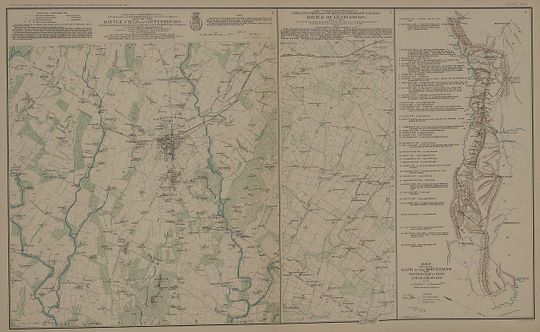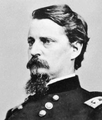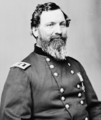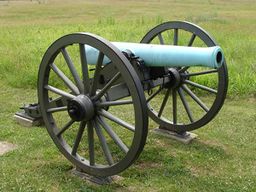معركة گتيسبرگ
| Battle of Gettysburg | |||||||
|---|---|---|---|---|---|---|---|
| جزء من the American Civil War | |||||||
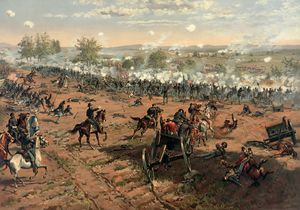 Pickett's Charge as depicted by Thulstrup in The Battle of Gettysburg | |||||||
| |||||||
| المتحاربون | |||||||
|
|
| ||||||
| القادة والزعماء | |||||||
| George G. Meade | Robert E. Lee | ||||||
| الوحدات المشاركة | |||||||
| Army of the Potomac[2] | Army of Northern Virginia[3] | ||||||
| القوى | |||||||
| 104,256 ("present for duty")[4][5] | 71,000–75,000 (estimated)[6] | ||||||
| الضحايا والخسائر | |||||||
|
23,049 total (3,155 killed; [7][8]14,529 wounded; 5,365 captured/missing) | 23,000–28,000 (estimated)[9][10] | ||||||
The Battle of Gettysburg (locally /ˈɡɛtɪsbɜːrɡ/ (![]() استمع), with an /s/ sound)[11] was fought July 1–3, 1863, in and around the town of Gettysburg, Pennsylvania, by Union and Confederate forces during the American Civil War. The battle involved the largest number of casualties of the entire war and is often described as the war's turning point.[12][13] Union Maj. Gen. George Meade's Army of the Potomac defeated attacks by Confederate Gen. Robert E. Lee's Army of Northern Virginia, halting Lee's invasion of the North.
استمع), with an /s/ sound)[11] was fought July 1–3, 1863, in and around the town of Gettysburg, Pennsylvania, by Union and Confederate forces during the American Civil War. The battle involved the largest number of casualties of the entire war and is often described as the war's turning point.[12][13] Union Maj. Gen. George Meade's Army of the Potomac defeated attacks by Confederate Gen. Robert E. Lee's Army of Northern Virginia, halting Lee's invasion of the North.
After his success at Chancellorsville in Virginia in May 1863, Lee led his army through the Shenandoah Valley to begin his second invasion of the North—the Gettysburg Campaign. With his army in high spirits, Lee intended to shift the focus of the summer campaign from war-ravaged northern Virginia and hoped to influence Northern politicians to give up their prosecution of the war by penetrating as far as Harrisburg, Pennsylvania, or even Philadelphia. Prodded by President Abraham Lincoln, Maj. Gen. Joseph Hooker moved his army in pursuit, but was relieved of command just three days before the battle and replaced by Meade.
Elements of the two armies initially collided at Gettysburg on July 1, 1863, as Lee urgently concentrated his forces there, his objective being to engage the Union army and destroy it. Low ridges to the northwest of town were defended initially by a Union cavalry division under Brig. Gen. John Buford, and soon reinforced with two corps of Union infantry. However, two large Confederate corps assaulted them from the northwest and north, collapsing the hastily developed Union lines, sending the defenders retreating through the streets of the town to the hills just to the south.[14]
On the second day of battle, most of both armies had assembled. The Union line was laid out in a defensive formation resembling a fishhook. In the late afternoon of July 2, Lee launched a heavy assault on the Union left flank, and fierce fighting raged at Little Round Top, the Wheatfield, Devil's Den, and the Peach Orchard. On the Union right, Confederate demonstrations escalated into full-scale assaults on Culp's Hill and Cemetery Hill. All across the battlefield, despite significant losses, the Union defenders held their lines.
On the third day of battle, fighting resumed on Culp's Hill, and cavalry battles raged to the east and south, but the main event was a dramatic infantry assault by 12,500 Confederates against the center of the Union line on Cemetery Ridge, known as Pickett's Charge. The charge was repulsed by Union rifle and artillery fire, at great loss to the Confederate army.[15]
Lee led his army on a torturous retreat back to Virginia. Between 46,000 and 51,000 soldiers from both armies were casualties in the three-day battle, the most costly in US history.
On November 19, President Lincoln used the dedication ceremony for the Gettysburg National Cemetery to honor the fallen Union soldiers and redefine the purpose of the war in his historic Gettysburg Address.
خلفية
الوضع العسكري

القوات المتقابلة
الاتحاديون
| كبار القادة (جيش الپوتوماك) |
|---|
|
Army of the Potomac, initially under Maj. Gen. Joseph Hooker (Maj. Gen. George Meade replaced Hooker in command on June 28), consisted of more than 100,000 men in the following organization:[19]
- I Corps, commanded by Maj. Gen. John F. Reynolds, with divisions commanded by Brig. Gen. James S. Wadsworth, Brig. Gen. John C. Robinson, and Maj. Gen. Abner Doubleday.
- II Corps, commanded by Maj. Gen. Winfield Scott Hancock, with divisions commanded by Brig. Gens. John C. Caldwell, John Gibbon, and Alexander Hays.
- III Corps, commanded by Maj. Gen. Daniel Sickles, with divisions commanded by Maj. Gen. David B. Birney and Maj. Gen. Andrew A. Humphreys.
- V Corps, commanded by Maj. Gen. George Sykes (George G. Meade until June 28), with divisions commanded by Brig. Gens. James Barnes, Romeyn B. Ayres, and Samuel W. Crawford.
- VI Corps, commanded by Maj. Gen. John Sedgwick, with divisions commanded by Brig. Gen. Horatio G. Wright, Brig. Gen. Albion P. Howe, and Maj. Gen. John Newton.
- XI Corps, commanded by Maj. Gen. Oliver Otis Howard, with divisions commanded by Brig. Gen. Francis C. Barlow, Brig. Gen. Adolph von Steinwehr, and Maj. Gen. Carl Schurz.
- XII Corps, commanded by Maj. Gen. Henry W. Slocum, with divisions commanded by Brig. Gens. Alpheus S. Williams and John W. Geary.
- Cavalry Corps, commanded by Maj. Gen. Alfred Pleasonton, with divisions commanded by Brig. Gens. John Buford, David McM. Gregg, and H. Judson Kilpatrick.
- Artillery Reserve, commanded by Brig. Gen. Robert O. Tyler. (The preeminent artillery officer at Gettysburg was Brig. Gen. Henry J. Hunt, chief of artillery on Meade's staff.)
During the advance on Gettysburg, Maj. Gen. Reynolds was in operational command of the left, or advanced, wing of the Army, consisting of the I, III, and XI Corps.[20] Note that many other Union units (not part of the Army of the Potomac) were actively involved in the Gettysburg Campaign, but not directly involved in the Battle of Gettysburg. These included portions of the Union IV Corps, the militia and state troops of the Department of the Susquehanna, and various garrisons, including that at Harpers Ferry.
الكونفدراليون
| كبار قادة (جيش شمال ڤرجينيا) |
|---|
|
In reaction to the death of Lt. Gen. Thomas J. "Stonewall" Jackson after Chancellorsville, Lee reorganized his Army of Northern Virginia (75,000 men) from two infantry corps into three.[21]
- First Corps, commanded by Lt. Gen. James Longstreet, with divisions commanded by Maj. Gens. Lafayette McLaws, George Pickett, and John Bell Hood.
- Second Corps, commanded by Lt. Gen. Richard S. Ewell, with divisions commanded by Maj. Gens. Jubal A. Early, Edward "Allegheny" Johnson, and Robert E. Rodes.
- Third Corps, commanded by Lt. Gen. A.P. Hill, with divisions commanded by Maj. Gens. Richard H. Anderson, Henry Heth, and W. Dorsey Pender.
- Cavalry division, commanded by Maj. Gen. J.E.B. Stuart, with brigades commanded by Brig. Gens. Wade Hampton, Fitzhugh Lee, Beverly H. Robertson, Albert G. Jenkins, William E. "Grumble" Jones, and John D. Imboden, and Col. John R. Chambliss.
الحفاظ على ميدان القتال
| معركة گتيسبرگ | |
| Protected area | |
M1857 12-Pounder "Napoleon" at Gettysburg National Military Park
Gettysburg, Pennsylvania.
| |
| البلد | |
|---|---|
| State | |
| County | Adams |
| البلديات | Cumberland, Franklin Straban |
| Campaign Theater |
Gettysburg Eastern |
| Landform | Gettysburg sill on the "Gettysburg plain"[22] (York Haven Diabase)[23] |
| Landmark | High Water Mark monument @ The Angle on Cemetery Ridge |
| Owners | private, federal |
| الموقع: Park Home (NPS.gov) | |
التخليد في طوابع وعملات الولايات المتحدة
انظر أيضاً
- Bibliography of the American Civil War
- Troop engagements of the American Civil War, 1863
- List of costliest American Civil War land battles
- Gettysburg Cyclorama, a painting by the French artist Paul Philippoteaux depicting Pickett's Charge
- Armies in the American Civil War
- Battles of the American Civil War
- Bibliography of Ulysses S. Grant
الهامش
- ^ Coddington, p. 573. See the discussion regarding historians' judgment on whether Gettysburg should be considered a decisive victory.
- ^ Official Records, Series I, Volume XXVII, Part 1, pages 155-168
- ^ Official Records, Series I, Volume XXVII, Part 2, pages 283-291
- ^ Official Records, Series I, Volume XXVII, Part 1, page 151
- ^ Busey and Martin, p. 125: "Engaged strength" at the battle was 93,921.
- ^ Busey and Martin, p. 260, state that "engaged strength" at the battle was 71,699; McPherson, p. 648, lists the strength at the start of the campaign as 75,000.
- ^ Official Records, Series I, Volume XXVII, Part 1, page 187
- ^ Busey and Martin, p. 125.
- ^ Busey and Martin, p. 260, cite 23,231 total (4,708 killed;12,693 wounded;5,830 captured/missing).
See the section on casualties for a discussion of alternative Confederate casualty estimates, which have been cited as high as 28,000. - ^ Official Records, Series I, Volume XXVII, Part 2, pages 338-346
- ^ Robert D. Quigley, Civil War Spoken Here: A Dictionary of Mispronounced People, Places and Things of the 1860's (Collingswood, NJ: C. W. Historicals, 1993), p. 68. ISBN 0-9637745-0-6.
- ^ The Battle of Antietam, the culmination of Lee's first invasion of the North, had the largest number of casualties in a single day, about 23,000.
- ^ Rawley, p. 147; Sauers, p. 827; Gallagher, Lee and His Army, p. 83; McPherson, p. 665; Eicher, p. 550. Gallagher and McPherson cite the combination of Gettysburg and Vicksburg as the turning point. Eicher uses the arguably related expression, "High-water mark of the Confederacy".
- ^ "Battle of Gettysburg". Encyclopædia Britannica. Britannica.com. 15 February 2017. Retrieved 3 July 2012.
- ^ Murray, Williamson; Hsieh, Wayne Wei-siang (2016). "The War in the East, 1863". A Savage War:A Military History of the Civil War. Princeton University Press. p. 278. ISBN 978-0-69-116940-8.
- ^ Symonds, pp. 49–54.
- ^ Loewen, James W. (1999). Lies Across America: What American Historic Sites Get Wrong. New York City, New York: Touchstone, Simon & Schuster, Inc. p. 350. Retrieved March 5, 2016.
Lee's troops seized scores of free black people in Maryland and Pennsylvania and sent them south into slavery. This was in keeping with Confederate national policy, which virtually re-enslaved free people of color into work gangs on earthworks throughout the south.
- ^ Simpson, Brooks D. (July 5, 2015). "The Soldiers' Flag?". Crossroads. WordPress.
[T]he Army of Northern Virginia was under orders to capture and send south supposed escaped slaves during that army's invasion of Pennsylvania in 1863.
- ^ Eicher, pp. 502–503.
- ^ Coddington, p. 122.
- ^ Eicher, p. 503.
- ^ Brown, Andrew (2006) [1962]. "GEOLOGY and the Gettysburg Campaign —Eleventh printing" (PDF). Pennsylvania: Bureau of Topographic and Geologic Survey. Retrieved 2010-02-19.
- ^ Smith II, R.C. & Keen, R. C (2004). "Appendix A: Regional Rifts and the Battle of Gettysburg" (PDF). p. 3. Retrieved 2010-02-21.
{{cite web}}: CS1 maint: multiple names: authors list (link)
المراجع
- Bearss, Edwin C. Fields of Honor: Pivotal Battles of the Civil War. Washington, D.C.: National Geographic Society, 2006. ISBN 0-7922-7568-3.
- Busey, John W., and David G. Martin. Regimental Strengths and Losses at Gettysburg, 4th ed. Hightstown, NJ: Longstreet House, 2005. ISBN 0-944413-67-6.
- Carmichael, Peter S., ed. Audacity Personified: The Generalship of Robert E. Lee. Baton Rouge: Louisiana State University Press, 2004. ISBN 0-8071-2929-1.
- Catton, Bruce. Glory Road. Garden City, NY: Doubleday and Company, 1952. ISBN 0-385-04167-5.
- Clark, Champ, and the Editors of Time-Life Books. Gettysburg: The Confederate High Tide. Alexandria, VA: Time-Life Books, 1985. ISBN 0-8094-4758-4.
- Coddington, Edwin B. The Gettysburg Campaign; a study in command. New York: Scribner's, 1968. ISBN 0-684-84569-5.
- Donald, David Herbert. Lincoln. New York: Simon & Schuster, 1995. ISBN 0-684-80846-3.
- Eicher, David J. The Longest Night: A Military History of the Civil War. New York: Simon & Schuster, 2001. ISBN 0-684-84944-5.
- Esposito, Vincent J. West Point Atlas of American Wars. New York: Frederick A. Praeger, 1959. OCLC 5890637. The collection of maps (without explanatory text) is available online at the West Point website.
- Foote, Shelby. The Civil War: A Narrative. Vol. 2, Fredericksburg to Meridian. New York: Random House, 1958. ISBN 0-394-49517-9.
- Fuller, Maj. Gen. J. F. C. Grant and Lee: A Study in Personality and Generalship. Bloomington: Indiana University Press, 1957. ISBN 0-253-13400-5.
- Gallagher, Gary W. Lee and His Army in Confederate History. Chapel Hill: University of North Carolina Press, 2001. ISBN 978-0-8078-2631-7.
- Gallagher, Gary W. Lee and His Generals in War and Memory. Baton Rouge: Louisiana State University Press, 1998. ISBN 0-8071-2958-5.
- Glatthaar, Joseph T. General Lee's Army: From Victory to Collapse. New York: Free Press, 2008. ISBN 978-0-684-82787-2.
- Harman, Troy D. Lee's Real Plan at Gettysburg. Mechanicsburg, PA: Stackpole Books, 2003. ISBN 0-8117-0054-2.
- Hattaway, Herman, and Archer Jones. How the North Won: A Military History of the Civil War. Urbana: University of Illinois Press, 1983. ISBN 0-252-00918-5.
- Keegan, John. The American Civil War: A Military History. New York: Alfred A. Knopf, 2009. ISBN 978-0-307-26343-8.
- Longacre, Edward G. The Cavalry at Gettysburg. Lincoln: University of Nebraska Press, 1986. ISBN 0-8032-7941-8.
- McPherson, James M. Battle Cry of Freedom: The Civil War Era. Oxford History of the United States. New York: Oxford University Press, 1988. ISBN 0-19-503863-0.
- Martin, David G. Gettysburg July 1. rev. ed. Conshohocken, PA: Combined Publishing, 1996. ISBN 0-938289-81-0.
- Murray, Williamson and Wayne Wei-siang Hsieh. "A Savage War:A Military History of the Civil War". Princeton: Princeton University Press, 2016. ISBN 978-0-69-116940-8.
- Nye, Wilbur S. Here Come the Rebels! Dayton, OH: Morningside House, 1984. ISBN 0-89029-080-6. First published in 1965 by Louisiana State University Press.
- Pfanz, Harry W. Gettysburg – The First Day. Chapel Hill: University of North Carolina Press, 2001. ISBN 0-8078-2624-3.
- Pfanz, Harry W. Gettysburg – The Second Day. Chapel Hill: University of North Carolina Press, 1987. ISBN 0-8078-1749-X.
- Pfanz, Harry W. Gettysburg: Culp's Hill and Cemetery Hill. Chapel Hill: University of North Carolina Press, 1993. ISBN 0-8078-2118-7.
- Rawley, James A. (1966). Turning Points of the Civil War. University of Nebraska Press. ISBN 0-8032-8935-9. OCLC 44957745.
- Sauers, Richard A. "Battle of Gettysburg." In Encyclopedia of the American Civil War: A Political, Social, and Military History, edited by David S. Heidler and Jeanne T. Heidler. New York: W. W. Norton & Company, 2000. ISBN 0-393-04758-X.
- Sears, Stephen W. Gettysburg. Boston: Houghton Mifflin, 2003. ISBN 0-395-86761-4.
- Symonds, Craig L. American Heritage History of the Battle of Gettysburg. New York: HarperCollins, 2001. ISBN 0-06-019474-X.
- Tagg, Larry. The Generals of Gettysburg. Campbell, CA: Savas Publishing, 1998. ISBN 1-882810-30-9.
- Trudeau, Noah Andre. Gettysburg: A Testing of Courage. New York: HarperCollins, 2002. ISBN 0-06-019363-8.
- Tucker, Glenn. High Tide at Gettysburg. Dayton, OH: Morningside House, 1983. ISBN 978-0-914427-82-7. First published 1958 by Bobbs-Merrill Co.
- Wert, Jeffry D. Gettysburg: Day Three. New York: Simon & Schuster, 2001. ISBN 0-684-85914-9.
- White, Ronald C., Jr. The Eloquent President: A Portrait of Lincoln Through His Words. New York: Random House, 2005. ISBN 1-4000-6119-9.
- Wittenberg, Eric J., J. David Petruzzi, and Michael F. Nugent. One Continuous Fight: The Retreat from Gettysburg and the Pursuit of Lee's Army of Northern Virginia, July 4–14, 1863. New York: Savas Beatie, 2008. ISBN 978-1-932714-43-2.
- Woodworth, Steven E. Beneath a Northern Sky: A Short History of the Gettysburg Campaign. Wilmington, DE: SR Books (scholarly Resources, Inc.), 2003. ISBN 0-8420-2933-8.
Memoirs and primary sources
- Paris, Louis-Philippe-Albert d'Orléans. The Battle of Gettysburg: A History of the Civil War in America. Digital Scanning, Inc., 1999. ISBN 1-58218-066-0. First published 1869 by Germer Baillière.
- New York (State), William F. Fox, and Daniel Edgar Sickles. New York at Gettysburg: Final Report on the Battlefield of Gettysburg. Albany, NY: J.B. Lyon Company, Printers, 1900. OCLC 607395975.
- U.S. War Department, The War of the Rebellion: a Compilation of the Official Records of the Union and Confederate Armies. Washington, DC: U.S. Government Printing Office, 1880–1901.
للاستزادة
- Adkin, Mark. The Gettysburg Companion: The Complete Guide to America's Most Famous Battle. Mechanicsburg, PA: Stackpole Books, 2008. ISBN 978-0-8117-0439-7.
- Bachelder, John B. The Bachelder Papers: Gettysburg in Their Own Words. Edited by David L. Ladd and Audrey J. Ladd. 3 vols. Dayton, OH: Morningside Press, 1994. ISBN 0-89029-320-1.
- Bachelder, John B. Gettysburg: What to See, and How to See It: Embodying Full Information for Visiting the Field. Boston: Bachelder, 1873. OCLC 4637523.
- Ballard, Ted, and Billy Arthur. Gettysburg Staff Ride Briefing Book. Carlisle, PA: United States Army Center of Military History, 1999. OCLC 42908450.
- Bearss, Edwin C. Receding Tide: Vicksburg and Gettysburg: The Campaigns That Changed the Civil War. Washington DC: National Geographic Society, 2010. ISBN 978-1-4262-0510-1.
- Boritt, Gabor S., ed. The Gettysburg Nobody Knows. New York: Oxford University Press, 1997. ISBN 0-19-510223-1.
- Desjardin, Thomas A. These Honored Dead: How the Story of Gettysburg Shaped American Memory. New York: Da Capo Press, 2003. ISBN 0-306-81267-3.
- Frassanito, William A. Early Photography at Gettysburg. Gettysburg, PA: Thomas Publications, 1995. ISBN 1-57747-032-X.
- Lyon Fremantle, Arthur J. The Fremantle Diary: A Journal of the Confederacy. Edited by Walter Lord. Short Hills, NJ: Burford Books, 2002. ISBN 1-58080-085-8. First published 1954 by Capicorn Books.
- Gallagher, Gary W., ed. Three Days at Gettysburg: Essays on Confederate and Union Leadership. Kent, OH: Kent State University Press, 1999. ISBN 0-87338-629-9.
- Gottfried, Bradley M. Brigades of Gettysburg. New York: Da Capo Press, 2002. ISBN 0-306-81175-8.
- Gottfried, Bradley M. The Maps of Gettysburg: An Atlas of the Gettysburg Campaign, June 3 – 13, 1863. New York: Savas Beatie, 2007. ISBN 978-1-932714-30-2.
- Grimsley, Mark, and Brooks D. Simpson. Gettysburg: A Battlefield Guide. Lincoln: University of Nebraska Press, 1999. ISBN 0-8032-7077-1.
- Guelzo, Allen C. Gettysburg: The Last Invasion. New York: Vintage Books, 2013. ISBN 978-0-307-74069-4. First published in 2013 by Alfred A. Knopf.
- Hall, Jeffrey C. The Stand of the U.S. Army at Gettysburg. Bloomington: Indiana University Press, 2003. ISBN 0-253-34258-9.
- Haskell, Frank Aretas. The Battle of Gettysburg. Whitefish, MT: Kessinger Publishing, 2006. ISBN 978-1-4286-6012-0.
- Hawthorne, Frederick W. Gettysburg: Stories of Men and Monuments. Gettysburg, PA: Association of Licensed Battlefield Guides, 1988. ISBN 0-9657444-0-X.
- Hoptak, John David. Confrontation at Gettysburg: A Nation Saved, a Cause Lost. Charleston, SC: The History Press, 2012. ISBN 978-1-60949-426-1.
- Huntington, Tom. Pennsylvania Civil War Trails: The Guide to Battle Sites, Monuments, Museums and Towns. Mechanicsburg, PA: Stackpole Books, 2007. ISBN 978-0-8117-3379-3.
- Laino, Philip, Gettysburg Campaign Atlas, 2nd ed. Dayton, OH: Gatehouse Press 2009. ISBN 978-1-934900-45-1.
- McMurry, Richard M. "The Pennsylvania Gambit and the Gettysburg Splash." In The Gettysburg Nobody Knows, edited by Gabor Boritt. New York: Oxford University Press, 1997. ISBN 0-19-510223-1.
- McPherson, James M. Hallowed Ground: A Walk at Gettysburg. New York: Crown Publishers, 2003. ISBN 0-609-61023-6.
- Petruzzi, J. David, and Steven Stanley. The Complete Gettysburg Guide. New York: Savas Beatie, 2009. ISBN 978-1-932714-63-0.
- Shaara, Michael. The Killer Angels: A Novel. New York: Ballantine Books, 2001. ISBN 978-0-345-44412-7. First published 1974 by David McKay Co.
- Stackpole, Gen. Edward J. They Met at Gettysburg. Harrisburg, PA: Stackpole Books, 1956, OCLC 22643644.
وصلات خارجية
|
| Find more about معركة گتيسبرگ at Wikipedia's sister projects | |
| Definitions from Wiktionary | |
| Media from Commons | |
| Quotations from Wikiquote | |
| Source texts from Wikisource | |
| Textbooks from Wikibooks | |
| Travel guide from Wikivoyage | |
| Learning resources from Wikiversity | |
| الصور | |
|---|---|
| المرئيات | |
- Battle of Gettysburg: Battle Maps, histories, photos, and preservation news (Civil War Trust)
- Animated map of the Battle of Gettysburg (Civil War Trust)
- Gettysburg National Military Park (National Park Service)
- Papers of the Gettysburg National Military Park seminars
- U.S. Army's Interactive Battle of Gettysburg with Narratives
- Military History Online: The Battle of Gettysburg
- Official Records: The Battle of Gettysburg
- The Brothers War: The Battle of Gettysburg
- Gettysburg Discussion Group archives
- List of 53 Confederate generals at Gettysburg
- Encyclopædia Britannica: Battle of Gettysburg
- National Park Service battle description
- A film clip "Blue and Gray At 75th Anniversary of Great Battle, 1938/07/04 (1938)" is available for free download at the Internet Archive [more]
قالب:Gettysburg Campaign قالب:Pennsylvania in the Civil War قالب:American Civil War campaigns in the Eastern Theater
- Pages using gadget WikiMiniAtlas
- Coordinates on Wikidata
- Pages including recorded pronunciations
- Articles with hatnote templates targeting a nonexistent page
- Geobox usage tracking for protected area type
- Pages with empty portal template
- معركة گتيسبرگ
- معارك حملة گتيسبرگ
- معارك الحرب الأهلية الأمريكية في پنسلڤانيا
- Battles of the Eastern Theater of the American Civil War
- 1863 في پنسلڤانيا
- معارك في پنسلڤانيا
- حملة گتيسبرگ
- ميدان قتال گتيسبرگ
- نزاعات 1863
- 1863 في الولايات المتحدة
- History of Adams County, Pennsylvania
- Union victories of the American Civil War
- وقفات أخيرة
- أحداث يوليو 1863


